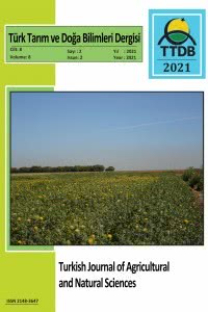Sources of Resistance to Races of Xanthomonas vesicatoria – Causal Agent of Bacterial Spot of Tomatoes
-
Sources of Resistance to Races of Xanthomonas vesicatoria – Causal Agent of Bacterial Spot of Tomatoes
Solanum lycopersicum, bacterial spot, sensitivity breeding,
___
- Bogatzevska, N., 2002. Plant pathogenic bacteria from genus Pseudomonas group syringae and genus Xanthomonas group vesicatoria and axonopodis-phases of the life cycle. (Dr. Sci), p. 370.
- Bogatzevska, N., Sotirova, V., 1992. Occurrence of two campestris pv. vesicatoria on tomato in
- Bulgaria, TGC Report 42: 11-12. Bogatzevska N., Sotirova, V., 2001-2002. Bacterial spot of tomato in Bulgaria: pathotypes and races. Genetics and Breeding 31: 59
- Ganeva, D., Bogatzevska, N., 2013. Evaluation of local accessions of pink tomato to
- Pseudomonas syringae pv. tomato and Xanthomonas bacterial spot. Plant Science, 50: 61-67. agents of Danailov, Zh., 2012. Breeding and seed production of tomato (Solanum lycopersicom L.).
- History, methods, achievements, trends. Academic Publishing House "Prof. Marin Drinov", Sofia, Bulgaria, p. 265. Danailov, Zh., Bogatzevska, N., Ganeva, D., 2008. Evaluation of esculentum Mill.) genotypes for resistance to Pseudomonas syringae pv. tomato (Race vesicatoria (Race T1, T3). International
- Scientific Conference, Union of Scientists – St. Zagora, June 5-6, online. (Licopersicon R0, R1) and Xanthomonas Ivanova, B., Bogatzevska, N., 2006. Resistance to rase T1 vesicatoria in tomato lines. Plant science 43: 435-438. Xanthomonas
- Minsavege, G., Bologh, B., Stall, R., Jones, J., 2003.
- Sotirova, V., Beleva L., 1975. Resistance of tomato wild species varieties and cultivars to
- Xanthomonas vesicatoria, C.R. Acad. Agric. 8, 43-47. Scott J., Francis, M., Miller, S., Somodi, G.., Jones, J., 2003. Tomato bacterial spot resistance derived from PI 114490; inheritance oh resistance to race T2. Amer. Soc. Hort. Sci. 128: 698-703.
- Scott J., Jones, J., Somodi, G.., Stall R., 1995. tomato Screening resistance to Xanthomonas campestris pv. vesicatoria, race T3. Hort. Science, 30: 579-5 for
- Scott J., Jonesand, J., Somodi, G.., 2001.
- Inheritance of resistance in tomato race T3 of the bacterial spot pathogen. J. Amer. Soc. Hort. Science 126: 436-441. Scott, J., Miller, S., Stall, R., Jones, J., Somodi, G., 19 Resistance to race T2 of the bacterial spot pathogen in tomato. Hort Science 32: 724-727. Sotirоva, V., Bogatzevska, N., 2000. Evaluation of tomato wild species for resistance to race
- T1 and T3 of Xanthomonas vesicatoria. Acta Physiologiae Plantarum, 22: 256-259. Sotirova,V., Bogatzevska, N., Lidanski, T., Vulkova, Z., 1998-1999. Screening of tomato lines for resistance to tomato and pepper- tomato pathotypes of Xanthomonas vesicatoria. Genetics and Breeding 29: 67
- ISSN: 2148-3647
- Yayın Aralığı: 4
- Başlangıç: 2014
- Yayıncı: Prof. Dr. Mevlüt AKÇURA
Violeta BOZHANOVA, Elena TODOROVSKA, Borjana HADZHIIVANOVA, Dechko DECHEV
Relationship between salinity stress and ion uptake of hyacinth (Hyacinthus orientalis)
Nezihe KOKSAL, Ilknur KULAHLIOGLU, Ebru ERTARGIN, Ayfer ALKAN TORUN
Yurdagul SIMSEK ERSAHIN, Jerry E. WEILAND, Ralph REED, And J. Fred STEVENS
Study on Fruit Staining of Citrus in the Eastern Mediterranean Region of Turkey
Serpil NAS, Pakize Gök GÜLER, Turgut GUVELOGLU
Chickpea (Cicer arietinum L.) in vitro micropropagation
Amina KADIRI, Yamina HALFAOUI, Louiza BOUABDALLAH, Zohra IGHILHARIZ
Training and Pruning of Apple and Modern Trends of Development – An Overview
Stefan GANDEV, Vasiliy DZHUVINOV
Nadejda PALOVA, Dimitrinka KRUSHEVA
Response of Dry Bean (Phaseolus vulgaris L.) Genotypes to Water Shortage
